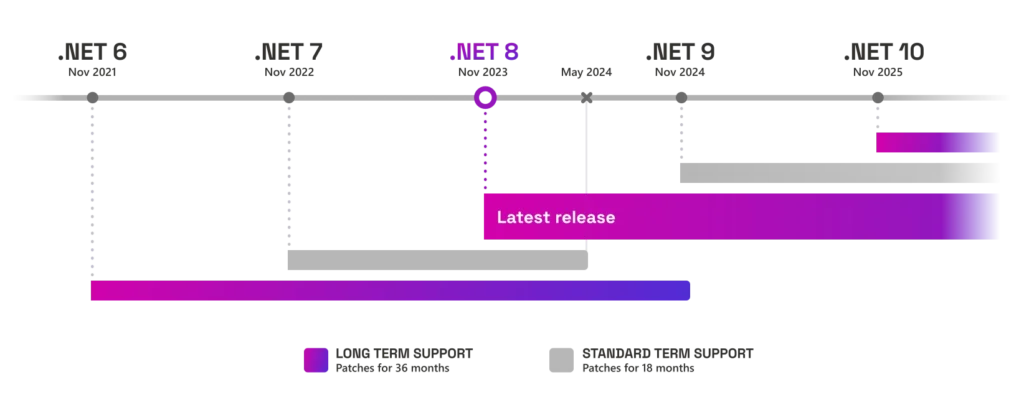.NET Framework and .NET: Navigating Use Cases and Upgrade Paths for Your Applications
Author: Tim Connolley
The .NET ecosystem has undergone significant changes in its evolution from .NET Framework to the modern, unified .NET platform. Understanding the capabilities and limitations of the different iterations of .NET is essential for making informed decisions regarding application development and migration strategies.
This document aims to provide a comprehensive analysis of the .NET Framework and .NET, focusing on their respective use cases and the technical considerations involved in upgrading existing applications.

Source: DALL-E
Overview of .NET Framework and .NET Core
The .NET Framework
The .NET Framework has been a fundamental part of Windows-based application development for over two decades, offering a broad range of features to build, deploy, and run desktop applications and web services. It is designed to work seamlessly with Windows, providing extensive support for Windows-specific features and APIs, Windows Forms, WPF, and ASP.NET Web Forms. It has an extensive class library, an integrated development environment (IDE), and strong backward compatibility.
.NET Core vs .NET
With the release of .NET 5+, Microsoft dropped the ‘core’ from .NET Core to clear up version naming conflicts with .NET Framework and to emphasize that it was the primary implementation for the .NET platform moving forward. The name ‘.NET Core’ is still used in reference to the most recent releases of .NET.
.NET
The unified .NET platform, its current release being .NET 8, represents the future of .NET development. It is a cross-platform, open-source framework designed for building modern applications that can run on Windows, Linux, and macOS. .NET consolidates the features of .NET Core, .NET Framework, and Xamarin into a single platform, offering improvements in performance, deployment flexibility, and development capabilities. Key features include support for microservices, containerization, and cloud-native development, alongside modern web application frameworks like ASP.NET Core. .NET’s cross-platform flexibility, performance improvements, and scalable deployment options make it an attractive choice for new projects requiring flexibility and efficiency.
Key Differences and Use Cases
Use Cases for .NET Framework
- Maintenance and extension of existing enterprise applications that rely on Windows-specific features.
- Development scenarios where application compatibility with older versions of .NET Framework is critical.
- Projects that use legacy technologies not fully supported or available in .NET, such as ASP.NET WebForms, WCF, and Workflow Foundation.
Use Cases for .NET
- Development of cross-platform applications and services that need to run on multiple operating systems.
- Applications requiring scalable deployment, such as microservices and containerized applications designed for cloud environments.
- High-performance web applications and services.
- Projects that benefit from the latest C# languages features and .NET APIs.
Upgrading Existing Applications: Migrating from .NET Framework to .NET
Evaluating Upgrade Necessity
The decision to migrate from the .NET Framework to .NET involves evaluating several factors, including the need for modernization, performance improvements, the need for cross-platform support, and the strategic direction toward a more flexible and scalable application architecture.
Support Considerations
Both .NET Framework and the unified .NET platform come with the assurance of long-term support. .NET Framework won’t see any major feature improvements like .NET but it will see security and bug fix updates that ensure the stability and security of existing applications. Meanwhile, .NET benefits from Microsoft’s modern support lifecycle, receiving regular updates, security patches, and performance improvements. Microsoft’s commitment to the .NET platform ensures continued support and evolution well into the future. For more information on support, visit Microsoft’s official .NET Framework Support Policy and .NET and .NET Core Official Support Policy.

Source: https://dotnet.microsoft.com/en-us/platform/support/policy/dotnet-core
Migration Strategies
Microsoft offers tools that are extremely helpful when choosing to upgrade to a later version of .NET. The .NET Upgrade Assistant and .NET Portability Analyzer help to understand the scope of changes required for migration.
- Incremental Migration: Adopting an incremental approach allows for the gradual migration of components, reducing risk and complexity.
- Full Migrations: In some cases, a complete rewrite in .NET might be justified, especially for applications requiring significant modernization.
Technical Challenges and Solutions
Migration challenges often include dependency management, differences in API availability, and changes in runtime behavior. Strategies to address these challenges include:
- Utilizing the .NET Portability Analyzer tool to assess compatibility.
- Refactoring code to use .NET Standard libraries where possible.
- Exploring alternative third-party libraries that support .NET.
Conclusion
The choice between .NET Framework and .NET, and the decision to migrate existing applications, should be based on a thorough assessment of project requirements, strategic goals, and the technical benefits of each framework. As the .NET ecosystem continues to evolve, staying informed and adaptable is key to leveraging its full capabilities in application development and modernization efforts.




